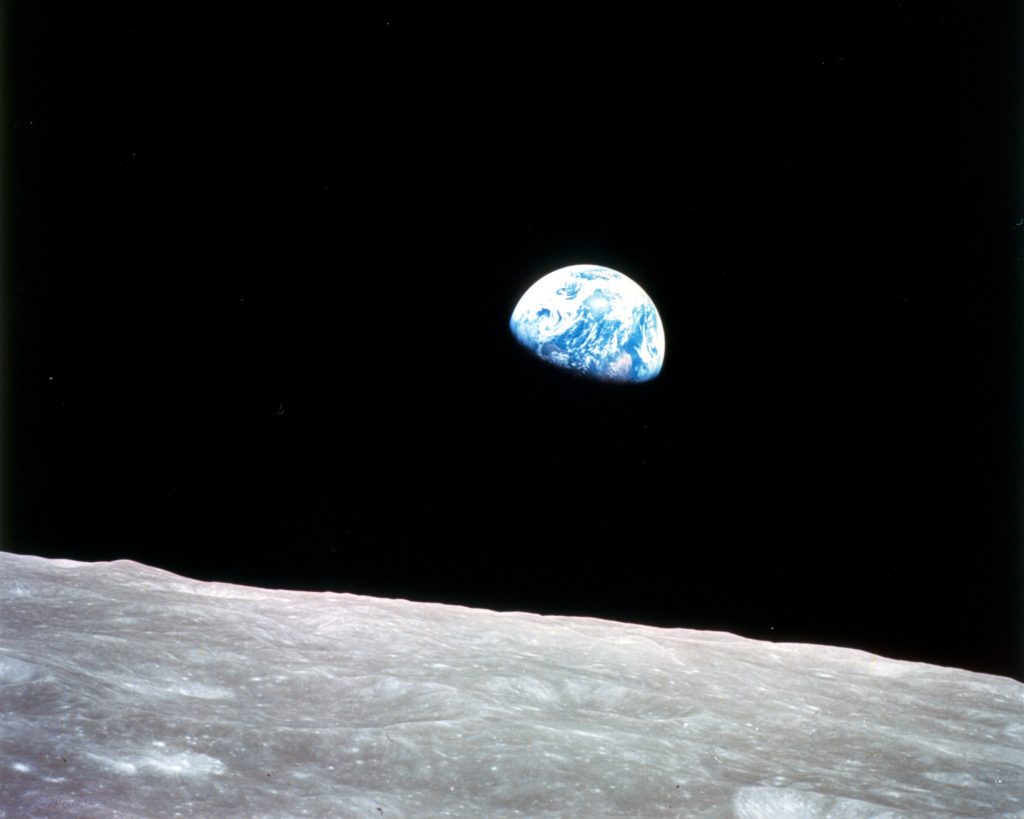Anders: Oh my God, look at that picture over there! There’s the Earth coming up. Wow, that’s pretty.
Borman: Hey, don’t take that, it’s not scheduled. (joking)
Anders: (laughs) You got a colour film, Jim?
Hand me that roll of colour quick, would you…
Lovell: Oh man, that’s great!– Audio excerpt of the conversation between the Apollo 8 astronauts during the taking of the ‘Earthrise’ photograph
Christmas Eve, 1968. As Apollo 8 rounds the dark side of the moon for the fourth time, the crew – Frank Borman, Jim Lovell and William Anders – prepare for a live broadcast from lunar orbit. It’s been one of the most politically turbulent and devastating years in American history: NASA have instructed them to ‘say something appropriate’. But as the command module peers over the horizon, a spectacle unveils itself from the night: before the crew is the only colour in the universe, suspended amongst the deep abyss, and above the boundless and bare grey. Anders does the only thing truly appropriate – he makes Earthrise.
It’s this process of making photographs during the Apollo missions that fascinates me. Of course, in an artistic sense; though, in this circumstance I believe that the physical and technical poiesis is so pronounced that it is essential to the artistic merit of the images. How did we photograph the moon? Over the festive period, I found that the explanation of this scientific feat is understated not only as a feat of photography, but also as a demonstration of the extraordinary potential of humankind. Science, when extrapolated to its furthest points, becomes art. As such, this article warrants two parts: this one, discussing Kodak’s involvement with the early stages of the NASA’s space exploration; the other, Hasselblad’s later collaboration with NASA. Locating information for this research has been quite piece-meal, so forgive me if these articles come across as relentlessly informative. They’re more a sort of record – one that I hope not only condenses this information more accessibly, but that also acts as an ode to a bygone era of technological and photographic revolution.
Launching the Lunar Orbiter Program
Without Kodak, we may never have set foot on the moon. Photography was integral before and once we had landed on the surface. In the early stages of NASA’s space program, Kodak was contacted to help investigate how and where to land safely on the moon for upcoming manned missions. Detailed photographs of the moon’s surface were therefore necessary as a reference for mapping different regions, which would be used to decide the landing sites of the Apollo capsules. Film was a mature technology, obtaining far higher resolution photographs than contemporary television; and so, NASA required a satellite with a high-resolution camera system that could travel unmanned to the moon, take photographs of the surface, develop them onboard automatically, and scan and transmit the images back to Earth. Remotely. Hence, in 1963, Kodak began installing a camera into an unmanned satellite – a commission which became known as the Lunar Orbiter Program.
Film emulsions in space
For the Lunar Orbiter 1 mission, the satellite camera utilised a dual lens system to simultaneously focus a wide-angle and a high-resolution image on the same exposure of film. Produced by Kodak, this exclusive roll was a mighty 79-metre length of unperforated, high-definition aerial film, SO-243. This meant that 212 dual frames could fit on a single roll. Even more economically, the roll was 70mm, rather than 35mm, to allow more detailed images to be captured. 243 was extremely fine-grained and had a high resolving power. Along one edge of the film was a thin band of pre-exposed data: this contained calibrated resolving power charts and grey scales which were later shown alongside each image for comparison and analytics. For both the Lunar Orbiter and Apollo programs, the films were fabricated on Kodak’s Estar thin base, the characteristic thinness of which allowed up to 33 percent more film to be carried on weight and bulk – critical in enabling efficient rocket launch.
Significantly, SO-243 was also highly resistant to fogging at the levels of radiation anticipated in space. The storage cassette for the film was specially shielded against ionising solar radiation. Evidently, radiation was a significant factor when selecting films for extra-terrestrial exploration. Early Apollo flights in the lunar region had recorded specific radiation levels, and from these, studies indicated that high-speed films accentuated fogging caused by exposure to radiation. This, in conjunction with the relatively intense light level on the day-lit surface of the moon, informed NASA and Kodak’s decision for the historic Apollo 11 mission. The films selected were Kodak Ektachrome EF SO-168 in 16mm and 70mm; Ektachrome MS SO-368 (ASA/ISO 64) in 16mm, 35mm and 70mm; and Kodak Panatomic-X black-and-white recording film SO-164 (ASA/ISO 80). Further, there were two types of 168: one was rated at ASA 160, the other ASA 1000. 168 was generally designed for the surface and interior photography in lower-light conditions. The primary difference between 168 and 368 was the haze filter pre-applied to the latter, rather than being attached to the lens.
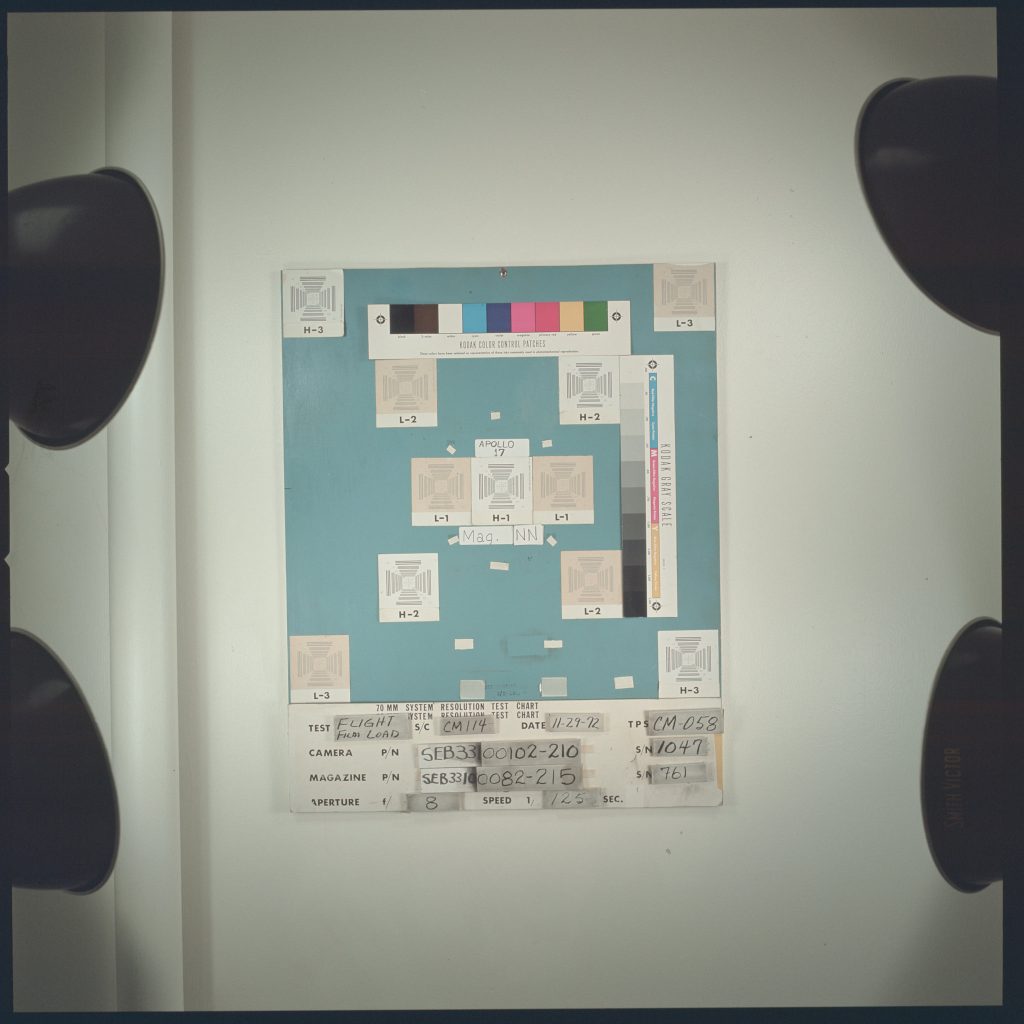
The Apollo 11 crew took several pre-flight shots to colour calibrate the exposures for accurate capture of the lunar surface (Image: NASA)
Between Armstrong, Aldrin and Collins, nine magazines of film were exposed, resulting in 1,407 photos – 550 of them were colour and 857 were black-and-white. Whilst the special Ektachrome emulsions were never commercially available – their secret formulas kept secret – a less light-sensitive rendition of Panatomic-X was sold with an ASA of 32.
The Lunar Orbiter camera system
A slight digression – but now, back to the satellite. How did it take photographs and how would they be transmitted back to Earth? The camera system onboard consisted of two lenses: a wide-angle, medium-resolution mode using an 80mm, f/2.8 Xenotar lens; whilst the high-resolution mode used a 610mm, f/5.6 Panoramic telephoto lens. The lenses were protected behind a quartz window, and so for each photograph a lifting flap was opened by a command transmitted from Earth. The wide-angle lens had a leaf shutter that gave exposure times of 1/25th, 1/50th or 1/100th, whilst the telephoto lens offered the same exposure times but utilised a focal plane shutter. When the shutters fired simultaneously, each exposure produced two images, the telephoto lens taking approximately five percent of the area of the wide-angle lens, but with a resolution that was eight times greater. With the spacecraft zooming at about 4,300 miles per hour, and taking photographs with low shutter times (dictated by the slow film speeds), you would expect the images to be blurred. However, a mechanism was installed to compensate for motion blur: it sensed the velocity-to-height ratio of the module by measuring the apparent motion of a small area of the lunar surface (as seen through the telephoto lens) and accordingly applied corrections to the aperture during shutter release.
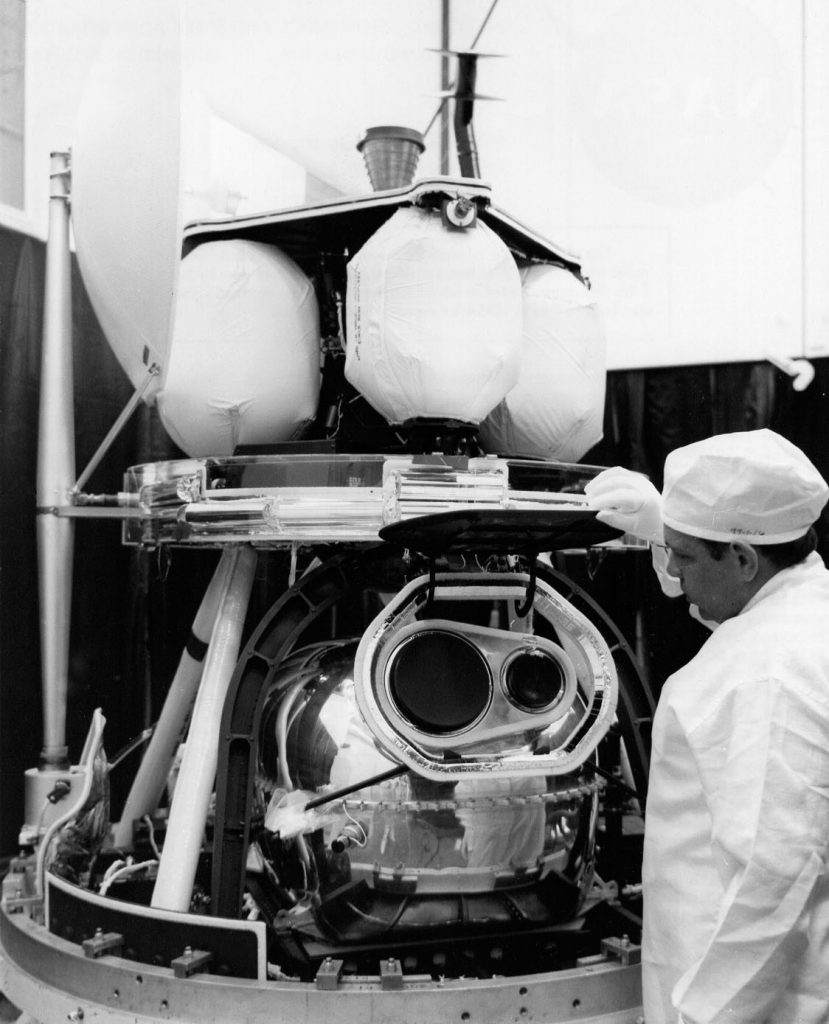
The Lunar Orbiter’s camera lens assembly during construction (Image: Honeysuckle Creek Tracking Station)
The BIMAT system
But there was a fundamental problem. Quite simply, film development is finicky and therefore risky. Conventionally (i.e. on Earth), in the development process of film, rolls are submerged in wet chemicals. Now, think about sending wet liquids on an unmanned, electronic machine on a distant, isolated mission to space: the risk is astronomical. Besides, how can film be developed and scanned unmanned? Hence, Kodak adapted a semi-dry, automated system that they had previously installed in USAF reconnaissance aircraft, known as the BIMAT system.
In the BIMAT system, there are two main components – the exposed film and the transfer film. The transfer film is lined with a gelatine layer that has been already soaked in a solution that developed and fixed the film in a single step. In a pressurised and temperature-controlled housing, the process presses the exposed film against the transfer film; this chemical transfer develops the exposed film. The developed roll is then advanced to a heated drum unit where it is dried, before being drawn over to a flying-spot scanner (photomultiplier). Here the image moves across a high-intensity beam of light a frame at a time, and the intensity of the light changes depending on the density of the image on the film. Denser parts of the film are opaquer, whereas thinner parts are more translucent. This data is read and converted into electronic signals. During the Lunar Orbiter program, one complete scan consisted of a scanned area of 2.54mm x 60mm, resulting in distinct banding visible in the images. For each millimetre of film scanned the process was repeated 286 times. Alongside telemetry data, the scan information was finally transmitted and reassembled by NASA back on Earth.
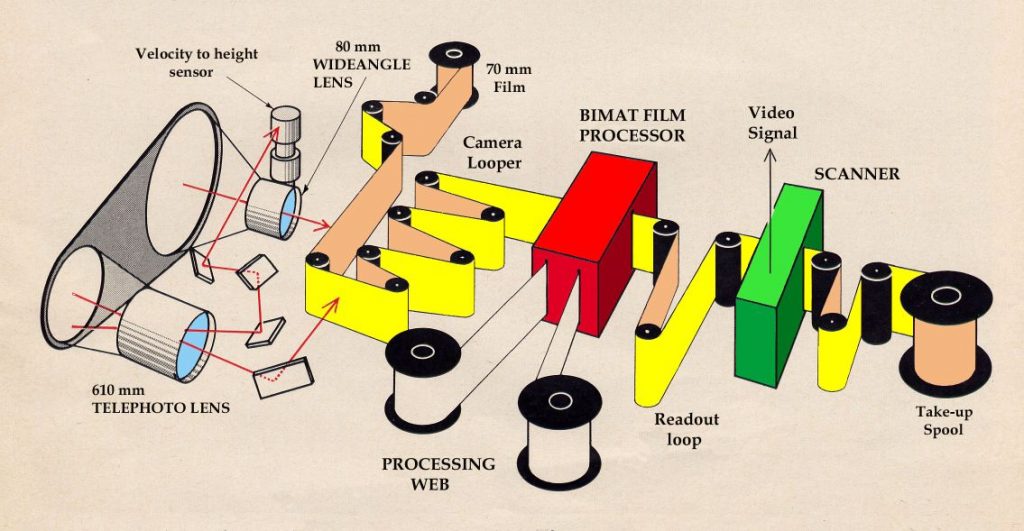
Diagram of the BIMAT system used throughout the Lunar Orbiter program (Image: Honeysuckle Creek Tracking Station)
The BIMAT system was highly advantageous from both logistic and photographic standpoints. Besides removing the need for liquids and their cumbersome storage containers, this semi-dry system did away with the fixing step whilst still producing high-quality images. This enabled the process to be fully automated whilst also simplifying problems regarding materials handling. As each exposure received fresh, active chemicals, the negatives were also more consistent. There were no crystalline deposits left on the film after separation – resulting in clearer scans – and the lamination of the two materials did not damage the emulsion layer.
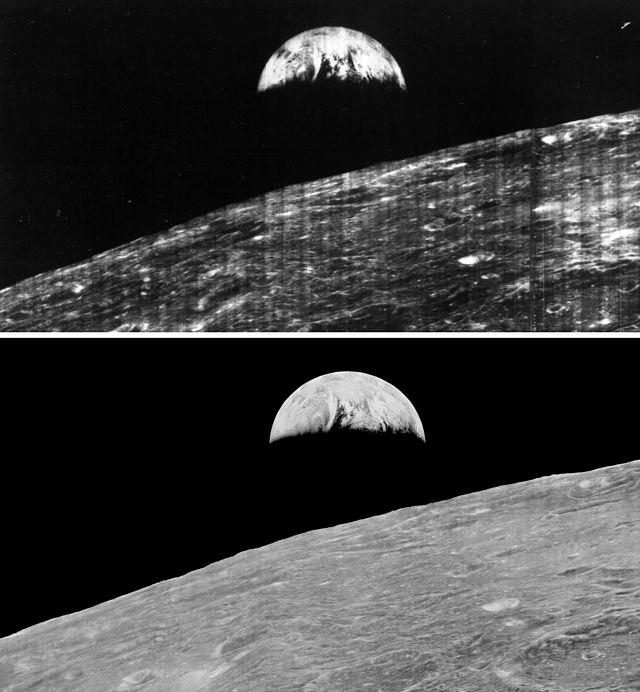
The first image of the earth taken from the moon; the original film scan with pronounced banding (top) is compared to a restored version of the image (Images: NASA (top) and The Lunar Orbiter Image Recovery Project, LOIRP (bottom))
Legacy
It was Lunar Orbiter 1 which returned the first photograph of Earth as seen from the Moon. The success of the first Orbiter resulted in the launch of four subsequent spacecraft between 1966 and 1967. They returned photography of 99 percent of the lunar surface – both on the near and far side – with a resolution down to one meter. All the goals for the Lunar Orbiter program were ultimately achieved, and the scanned photographs transmitted were instrumental to the planning of the Apollo missions.
It was one small, understated step in the space race, but it led to one giant leap for mankind.
(Featured image: NASA / LOIRP. All images credited to NASA originate from NASA’s Image and Video Library and follow NASA’s Media Usage Guidelines.)
